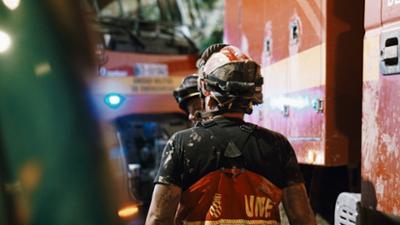

Interview with Captain Borja Varela of the Emergency Military Unit (Unidad Militar de Emergencias - UME) on their response during the floods in Valencia
What technology and equipment were key for UME's efforts in the flooding in Valencia? Can you give some examples of how drones, mapping systems and advanced communication tools have been used to streamline operations?
Capitan Varela: In this operation, the use of advanced technology was essential to optimise the response. Drones, for example, allowed us to gather information in the most affected and hard-to-reach areas, which facilitated the planning and prioritisation of rescue tasks. The drones were also able to create 3D maps of damaged infrastructure, which is of great use for analysis and decision-making on the ground. We have also been supported by army, air force and navy helicopters, which have carried out reconnaissance and search missions, expanding our real-time monitoring capability and allowing rapid deployment of equipment and supplies to hard-to-reach areas. All this information is included in our mapping systems, so all units can work in a coordinated and precise way, which is essential for a response of this magnitude.
The UME is known for its capacity for innovation and adaptation. What other specialist resources have been deployed in Valencia to deal with the challenges caused by the storm?
Capitan Varela: In addition to the drones and helicopters, we have deployed canine units with dogs trained to find people underwater, buried in mud or under rubble. Also, our debris and road clearance teams have been working hard with heavy machinery to open access routes and main roads, allowing aid to enter and facilitating evacuations. In addition, we have used high-capacity drainage equipment, essential for removing water and mud from houses and garages, both in urban areas and in the outskirts of the affected localities.
In this emergency specialist teams were also employed to work in polluted environments, with the aim of removing organic waste that was rotting due to the power cut, thus avoiding public health problems. In addition to these resources, other units of the Armed Forces and Royal Guard have also been present on the ground, contributing support tasks and providing invaluable skills.
In this operation, how was coordination with other emergency services organised? And what was the role of the armed forces in this task?
Capitan Varela: Coordination was effective and required detailed planning by the emergency operational coordination centre, where the UME has worked closely with the Law Enforcement Agencies (LEAs) and the emergency services of Valencia and other autonomous communities that have sent reinforcements. This was the largest deployment of armed forces in Spain in this century, with more than 8,500 military personnel on the ground. Each of the corps has provided both personnel and specialised capabilities: the Army, for example, deployed helicopters for transport and extraction of damaged vehicles in hard-to-reach areas. As well as this, the Army deployed engineer units to clear roads and remove rubble, and also contributed staff to pump mud and water from critical areas. The Navy has provided an amphibious assault ship for logistical and medical support, as well as divers for reconnaissance in flooded areas and minehunters and water drones for locating submerged vehicles. The Airforce, on the other hand, provided air transport and helicopter which, along with those of the navy and the army enabled the entire affected area to be continuously supported.
What were the main challenges of this operation in Valencia compared to other emergency situations?
Capitan Varela: One of the greatest challenges in Valencia was the scale of the affected area, which covers 54,000 km². In addition to this, it was difficult to access affected areas due to the large numbers of vehicles, mud and rubble, which was one of the biggest obstacles we faced.
In some areas, initial access was only possible with helicopters and drones which mapped the terrain in real-time, providing essential information to make decisions and redirect our efforts. Another significant challenge was the removal of water and mud from urban infrastructures (it is calculated that between 4 and 5 million m3 of mud), necessitating the continuous use of high-capacity pumping equipment.
The team of psychologists has also been working tirelessly, both with our responders and civilian staff. Working for a prolonged period of time in an area with such a high number of affected people or working in the morgue pose psychological challenges, but thanks to the work of this team, it has been possible to perform these tasks with minimal impact on the operations. Coordinating more than 8,500 troops and equipment from so many different units has also been a major logistical challenge, but thanks to previous experience in joint operations, we have been able to maintain total organisation and synchronisation of actions.
What has been learnt in previous operations which has been of use to improve the response on this occasion?
Capitan Varela: Every operation provides us with valuable lessons. On this occasion, one of the key factors was the pre-positioning of resources in vulnerable areas, which enabled us to respond quickly at the critical time. We have also implemented improvements in our communication and advanced mapping systems, which have allowed us to work in a fully integrated way with the rest of the Armed Forces and emergency services. The 3D maps generated by drones and the use of helicopters for real-time recognition have been strategic tools that allowed us to make decisions based on up-to-date data, adjusting our deployment depending on the needs on the ground.
Based on this operation in Valencia, what are the UME's recommendations to improve prevention and preparation in regions vulnerable to storms and floods like this one?
Capitan Varela: Powerful storms are phenomena of increasing frequency and intensity, so prevention must be a priority. It is also important that the public is informed of evacuation routes and safety protocols, especially in high risk areas. Training programmes and drills are also necessary, as they enable the population to know how to act and collaborate with emergency services in extreme risk situations.
To finish, Capitan Varela, what message would you like to send to citizens on the importance of collaboration and preparedness for climate emergencies such as the Valencia floods?
Capitan Varela: In emergencies, collaboration and preparedness make a big difference. We want to remind citizens that following the instructions of Law Enforcement Agencies and staying up-to-date from official sources is key. The UME and all the Armed Forces, along with LEAs and emergency services are here to protect and support the population, but safety starts in every home too. The collaboration of citizens is key for us to be able to act quickly and effectively in situations as critical as the Valencia floods.





